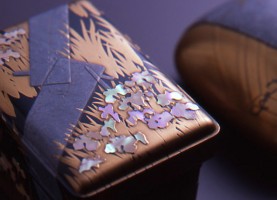

漆器は英語で「ジャパン」といい、日本の工芸品の代表格といえます。堅牢でしかも美しく肌ざわりのよい漆は、生活用具や装飾品の塗料として理想的で、もともとは中国から伝えられました。平安時代(8 末~12 世紀)の 宮 廷の漆器生産にはじまる 京 漆器は、貴族好みの 瀟 洒な仕上がりを伝統としています。室町時代(14~16 世紀)には茶道の影響を受けた「 東 山時代物」といわれる名品が多くつくられました。塗りや加 飾 に様々な技法があり、真塗りや華麗な蒔絵などが 京 漆器の代表となっています。
Japanese black lacquer is one of Japan’s most traditional crafts, and the term “japan” in English is still used to refer to both black lacquer and lacquer ware. Durable, with a beautiful texture and sheen, lacquer ware was originally introduced to Japan from China, and has long been treasured for its combination of utilitarianism and beauty. Kyoto lacquer ware was first produced for the imperial court during the Heian Period(8th-12th centuries) and is characterized by the exquisite workmanship and decoration favored by the aristocracy. Numerous famous “Higashiyama Era” pieces influenced by the tea ceremony were produced during the Muromachi Period(14th-16th centuries). While various techniques are used for lacquer application and decoration, Kyoto lacquer ware is noted for its pure black lacquer finish or exquisite pictures inlaid into the lacquer.
漆芸の高度な技を
小さな「写し」に込めた、掌に載る国宝
A palm-sized national treasure.
A miniature copy incorporating advanced lacquerwork techniques.



